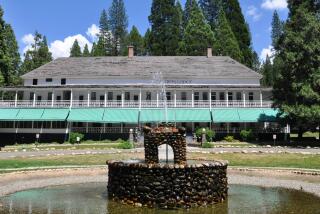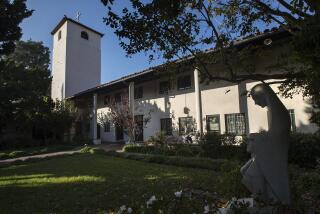Historic Maryland Site Awaits Recycling Into Housing
- Share via
SILVER SPRING, Md. — With a mini-village inhabited by a pagoda, windmill, castle and the hulking remains of a 19th century hotel, the National Park Seminary looks a bit like a theme park for adults.
Up close, however, it’s clear that the abandoned site near the Capital Beltway is missing the theme-park tidiness of a fantasy land. Stones on the castle have crumbled away, paint peels off the windmill and a sign on the boarded-up hotel warns of asbestos.
During its 114-year life span, the 32-acre site has been a resort for summer-weary Washingtonians, a finishing school for girls and a convalescent home for injured soldiers. But it has been largely abandoned in the last few decades, falling victim to decay and neglect.
The seminary will begin life anew this year. After decades of trying to find a new use for the site, a builder selected by Montgomery County will preserve the 25 historic buildings and convert them to housing.
“Something is finally happening and what is happening looks good,” said Bonnie Rosenthal, a member of the group called Save Our Seminary, which worked to protect the buildings.
A Wisconsin-based developer will spend $80 million to convert the property and a nearby field into 255 units of homes, condominiums and apartments. The Alexander Co. hopes to break ground within nine months, and the first residents could move in by 2006.
“When we look at the site, we see a fabulous opportunity for housing,” said Natalie Bock, development property manager for Alexander.
Listed on the National Register of Historic Places, the seminary sits on a leafy hillside next to the Walter Reed Army Hospital Annex and overlooks the Capital Beltway.
It was first developed as a hotel, opening in 1890 as a relatively rural retreat for city dwellers. But it quickly failed and, in 1894, was converted into a school known as the National Park Seminary.
The school built an eclectic jumble of buildings around the original hotel, including an assortment of sorority houses that reflected architecture from different parts of the world. It added a ballroom, chapel and dotted the grounds with sculptures.
In 1942, the Army absorbed the seminary into Walter Reed and used it to house injured World War II soldiers. It continued to use some of the buildings as office space, but by the mid-1990s, most of the buildings sat empty and boarded up.
The Army showed little interest in preserving the space, and the buildings began to crumble from water damage. Fire destroyed a playhouse, and vandals spirited away stained-glass windows and statues.
“They [Army officials] haven’t really been the best stewards of the historical property,” said Lisa Rother, a Montgomery County planner who worked on the project. “We are working against time to stabilize these buildings.”
Under an agreement with the Army, the county will buy the seminary and then sell it to Alexander, Rother said. Alexander plans to restore the site with the help of builders Eakin / Youngentob of Arlington, Va., and Baltimore-based Struever Bros., Eccles & Rouse.
The developers plan to build about 90 homes in a field across the street, the sale of which will help finance restoration of the older buildings.
The hotel will probably be converted to apartments, some of which will be designated as affordable housing. Buildings such as the gym will be made into condominiums, Bock said. The sororities, including the pagoda, will be turned into single-family homes.
“The pagoda would be a funky place to live,” she said. “In every market here are some people who want to live in a unique living environment.”
Because the site is listed on the National Register, much of the work will have to be approved by the county’s historical preservation commission and the Maryland Historical Trust. That means, if possible, original windows and building materials must remain, Bock said.
In some cases, that may be difficult. Extensive water damage has collapsed some roofs and floors. Bock said some buildings, such as a dormitory that used to house senior seminary students, may have to be scrapped.
Members of Save Our Seminary accept that some buildings may not be salvageable. But they are thrilled to have the restoration underway, even if it means an influx of about 300 new neighbors to their quiet community.
“We’re realistic,” Rosenthal said. “This will increase the value of the whole area.”
More to Read
Sign up for Essential California
The most important California stories and recommendations in your inbox every morning.
You may occasionally receive promotional content from the Los Angeles Times.













